“Now, Voyager”: Why the 1942 screen classic with Bette Davis and Paul Henreid will never age

“Box office dynamite—that’s ‘Now, Voyager’.” Those are the first words of Naka ‘s “Now Voyager” Variety film review, as published August 19, 1942. Continuing in the very same review: ‘Here is drama heavily steeped in the emotional tide that has swept its star, Bette Davis, to her present crest, and it’s the kind of drama that maintains Warners’ pattern for box office success. (…) It affords Miss Davis one of her superlative acting roles, that of a neurotic spinster fighting to free herself from the shackles of a tyrannical mother. (…) For Henreid, perhaps, this is his top role in American pictures; he neatly dovetails and makes believable the sometimes underplayed character of the man who finds love too late.’

The film tells the story of Boston heiress Charlotte Vale (in the beginning unglamorously portrayed by Bette Davis), a sheltered, frumpy, and middle-aged neurotic who is driven to a nervous breakdown by her domineering mother (Gladys Cooper), but with the help of a soft-spoken idealized therapist (Claude Rains), she is transformed into a modern, secure and attractive young woman. During an ocean voyage to South America, she meets a suave man, Jerry Durrance (Paul Henreid), and blooms as a woman. Durrance, unhappily married to a woman he dares not to hurt, has a young daughter Tina (played by the then twelve-year-old promising juvenile actress Janis Wilson in an uncredited role). She is an emotionally depressed child victimized by the insecurity of their unsettled home. Ultimately, Charlotte Vale and Jerry Durrance end up in a platonic relationship in which she keeps Tina, who in the meantime, is in the process of recovering, while Henreid stays with his unwanted wife.

“Now, Voyager” is an unabashed first-rate soap opera—or a woman’s picture, if you wish—and as such, it’s one of the very best of its kind, thanks to Warner Bros. expertise. At the same time, the powerful drama is backed by Max Steiner’s lush and Academy Award-winning musical score which is almost as much a part of the film as the actors. Bette Davis, one of Hollywood’s queens in the 1940s, made the film’s heroine a touching, dignified, and truly believable woman.
Miss Davis was not the first choice to play the role of Charlotte Vale, though. Irene Dunne, along with Charles Boyer, her co-star in “Love Affair” (1939), were considered to be perfect for the leading roles. Producer Hal B. Wallis also offered the female lead to Norma Shearer, and although she was fond of it, she had already made up her mind to retire from the screen after George Cukor’s “Her Cardboard Lover” (1942), due to her eye problems. When Irene Dunne heard that the script had also been discussed with Norma Shearer, she declined as well, fearing that both actresses were played against each other. Then Ginger Rogers was offered the part. She liked it, but weeks passed by for her to reply, and even after Wallis sent her a wire while she was on her ranch on the Rogue River, she did not respond, so finally the part went to Bette Davis, who was eager to play it.
One of the most famous and landmark scenes of the film is when Paul Henreid lights two cigarettes simultaneously and gallantly hands one of the cigarettes to Bette Davis, thereby starting a new custom (in an era when people obviously weren’t aware of the danger of smoking). The film became highly successful: “Now, Voyager” was Warner Bros.’s fourth biggest grossing film of 1942.
Compared to the then-established two-time Academy Award-winner Bette Davis, Mr. Henreid only had a few years of experience in Hollywood. After leaving Austria in the mid-1930s, he first settled in London and then moved on to the West Coast. So, although pretty much a newcomer in Hollywood when “Now, Voyager” was made, his performance was well-received. The New York Herald Tribune wrote, ‘Paul Henreid achieves his full stature as a romantic star’ while Time praised him as ‘Hollywood’s likeliest leading man who acts like a kind and morally responsible human being.’

In his autobiography “Ladies Man” (1984), Paul Henreid remembers Bette Davis as ‘a solid master of her craft’: “I found her a delight to work with, and we got along famously. In fact, a very close friendship started between us, and she remained a dear, close friend—and always a very decent human being.” The atmosphere on the set was amiable and supportive, although Miss Davis did have problems with her co-star Bonita Granville (who played the part of Charlotte’s young niece June Vale). “She was bitchy in the film and off. I don’t remember the details, but she struck me as flighty and gossipy,” she told Boze Hadleigh in his interview book “Bette Davis Speaks” (1996).
Principal photography of “Now, Voyager” began on the Warner lot on April 7, 1942, and ended on June 23, with retakes on July 3. The film was released in the U.S. on October 31, 1942. “Casablanca,” another Hal B. Wallis production, also starring Paul Henreid and Claude Rains (a frequent performer in Wallis’ pictures), was released a few months later on January 23, 1943, and was almost shot simultaneously at Warner Bros., from May 25 until August 3. Over the years, “Casablanca” gained a more popular following than “Now, Voyager” did; in 1998, a novel entitled “As Times Goes By,” written by Michael Walsh for Warner Books, follows the characters of Rick, Ilsa, Victor (Paul Henreid), Sam, and Louis (Claude Rains) after they left Casablanca.

When originally scheduled to direct “Now, Voyager,” filmmaker Edmund Goulding wrote a treatment for the film, but he fell ill and was unable to direct the film. Michael Curtiz then was assigned as director, as soon as he had finished shooting another Wallis production called “Yankee Doodle Dandy” (1942) with James Cagney. Still, from the very start, it became clear that Curtiz and Bette Davis couldn’t get along. Finally, producer Hal B. Wallis decided to go with a new director, London-born Irving Rapper. “He was a pleasant, amusing Englishman. He liked Bette, and she liked him,” Wallis recalled in “Starmaker,” his 1989 mémoires . Irving Rapper was a vocal coach, dialogue director, and assistant director in the 1930s who, prior to “Now, Voyager,” had directed only three features, including “One Foot in Heaven” (1941) starring Fredric March and Martha Scott, and “The Gay Sisters” (1942) with Barbara Stanwyck. In the end, just like Bette Davis, he was not the first choice by all means, but he turned out to be the right one.
Four years later, Irving Rapper and his three leading actors from “Now, Voyager”—Bette Davis, Paul Henreid, and Claude Rains (Davis’ favorite co-star)—were reunited with the drama “Deception,” also made at Warner Bros. (this one without Hal B. Wallis). In 1964, Paul Henreid directed Bette Davis (playing twin sisters) in the crime drama “Dead Ringer,” with his daughter Monika Henreid playing a supporting role.
Irving Rapper and Bette Davis later worked together again in “The Corn Is Green” and “Another Man’s Posion’ (1951). “Irving has directed some of my best pictures,” she said in later interviews.

Author Olive Higgins Prouty wrote four novels about the wealthy Vale family in Boston (“Now, Voyager” being the third). She sold the “Voyager” rights to Wallis for $35,000 in October 1941, and made several suggestions. She preferred Technicolor to be used, with the flashbacks shown in subdued colors as if seen through a veil, and she had laid down a scheme for particular sequences. Wallis decided to go ahead and ignore them completely, but after she had seen the film in her New England home with twenty-five friends, ‘all of them applauded,’ Wallis wrote in his autobiography. She wrote him a letter, saying that ‘the plot follows very closely that of my book and the personalities of the various characters have been carefully observed and preserved.’

Finally, film director Irving Rapper, born in 1898 in London, passed away at age 101 in 1999 in Woodland Hills, California, of natural causes. Never really in the spotlights, there’s not too much written about him. Authors Charles Higham and Joel Greenberg did include him in their interview book “The Celluloid Muse: Hollywood Directors Speak” (1969), a collection of fifteen interviews with film directors who spent most of their careers working in Hollywood. In their introduction of the Irving Rapper interview, they describe his whereabouts at the time of the interview: ‘Irving Rapper’s apartment is set high in a glistening white building in the very heart of Hollywood. Only a stone’s throw from Hollywood Boulevard, with its seedy spangle of light-signs, its driven restless sixties people, and its ever-skulking hustlers, Rapper inhabits a seemingly sealed-off forties world. As so often in Hollywood, fantasy and reality seem one, so that as you enter the hall, where a super-efficient blonde announces your arrival directly from the reception desk to the host’s telephone, you could easily be in a scene from a vintage Bette Davis picture, and you half expect to see her charge stormily at any moment through the glass window doors, ready for an argument with David Brian or Bruce Bennett—those lost figures of Hollywood’s past. Chez Rapper, the atmosphere of that past exists. Comfortably plump and relaxed, with an elegant and cultivated personality, he is utterly unlike the brisk new generation of grey-suited, fiercely efficient Hollywood men. (…) Like so many Hollywood talents, he has been put firmly—and one hopes only temporarily—on the shelf by the newest generation, but looking round his apartment, you see the compensations: Chinese lampstands ‘fit for a museum,” magnificent paintings crowded tightly up of a wall, a louvered cocktail recess, an atmosphere of spacious, glossy luxury. And beyond the great windows and the penthouse balcony, the whispering traffic, the horn-bleeps and the diamond shine of an ocean of lights: Los Angeles.’
Just for the record, even though “Now, Voyager” isn’t mentioned in AFI’s list of 100 Greatest American Films of All Time, the film ranks at #23 in AFI’s 100 Greatest Love Stories of All Time, while Bette Davis’ closing line, ‘Oh, Jerry, don’t let’s ask for the moon… we have the stars!’ is at #46 in AFI’s Greatest Movie Quotes of All Time. In 2007, “Now, Voyager” was selected for preservation in the United States National Film Registry by the Library of Congress as being ‘culturally, historically, or aesthetically significant.’
“Now, Voyager” (1942, trailer)
NOW, VOYAGER (1942) DIR Irving Rapper PROD Hal B. Wallis SCR Casey Robinson (novel ‘Now, Voyager’ [1941] by Olive Higgins Prouty) CAM Sol Polito MUS Max Steiner ED Warren Low CAST Bette Davis ( Charlotte Vale ), Paul Henreid ( Jerry Durrance ), Claude Rains ( Doctor Jaquith ), Gladys Cooper ( Mrs. Vale ), Bonita Granville ( June Vale ), John Loder ( Elliott Livingston ), Ilka Chase ( Lisa Vale ), Mary Wickes ( Dora Pickford ), Janis Wilson ( Tina Durrance )
- Click to share on Twitter (Opens in new window)
- Click to share on WhatsApp (Opens in new window)
- Click to share on Telegram (Opens in new window)
- Click to share on LinkedIn (Opens in new window)
- Click to print (Opens in new window)
- Click to email a link to a friend (Opens in new window)
Begin typing your search above and press return to search. Press Esc to cancel.

Discover more from FILM TALK
Subscribe now to keep reading and get access to the full archive.
Type your email…
Continue reading
You must be logged in to post a comment.
Things you buy through our links may earn Vox Media a commission.
75 Years Later, Now, Voyager Remains a Poignant Depiction of Mental Illness

About 23 minutes into Now, Voyager comes one of the most resplendent transformations in all of cinema.
Charlotte Vale (played with trademark intensity and brutal grace by Bette Davis) begins the film as an archetypal spinster figure. Her eyebrows are unruly, clothes dowdy, and a definitive air of anxiety cloaks her. She comes across as an exposed nerve. But at that 23-minute mark, Charlotte is transformed. When the camera tilts upward to her luminescent face, half-shrouded by her hat, she’s glamorous and beautiful in ways she hadn’t been before. The change isn’t just cosmetic. It’s a reflection of an interior transformation that’s still in progress — thanks to an extended stay in a sanitarium — from a mentally strained spinster to a woman charting her own path.
In the years since its release, the film has garnered a reputation as Davis’s best performance and a quintessential example of the women’s picture , a proto-feminist subgenre that took shape in 1930s Hollywood that made the interior lives of complex women its terrain. When I watched the 1942 film — which celebrates its 75th anniversary this year — for the first time as a teenager, it wasn’t the glamour or even the stirring romance that captured my imagination. It was the knotted story about Charlotte’s struggle with mental illness that I was drawn to because it offered something I hadn’t seen before or since in cinematic madwomen: hope.
Today, Now, Voyager remains a timeless portrait of a woman who pulls herself back from the edge of madness to create a life she’s proud to live, with the help of both psychiatry and her own willpower. The film is buttressed by sleek, highly efficient Hollywood production and the moving performances of the cast, notably Davis and Claude Rains as Dr. Jaquith, who helps usher Charlotte into this next phase of her life. Most poignantly, Now, Voyager is a curious outlier in the pantheon of American cinema that concerns itself with women living with mental illness. Few films offer the kind of blistering hope and empathy that has made Now, Voyager endure.
Films featuring mentally ill characters — consider Glenn Close’s maniacal portrayal in Fatal Attraction, Angelina Jolie’s charismatic turn in Girl, Interrupted , and the hothouse women of Tennessee Williams adaptations — often treat these women with emotional distance. Their contorting faces and bodies are a spectacle, while the particulars of their mind remain opaque. It would be difficult to cover all the permutations of madwomen, but they often fall into a few categories: cautionary true-life tales ( Sylvia; The Three Faces of Eve ), deliriously fun vixens who give way to toxicity and violence ( Girl, Interrupted; The Craft; Fatal Attraction ), vehicles for brutalization ( A Streetcar Named Desire ), and women in horror films ( Black Swan being a notable recent addition to the canon). Others slink through noir, like the overheated Technicolor Leave Her to Heaven and sharp The Dark Mirror . This is a pantheon of women whose aches and ailments, desires and downfalls I have been studying for years — partially out of need. Through most of my life grappling with mental illness, I have had no friends or family who, at least openly, dealt with similar issues. So I turned to the screen to find communion. While I personally love many of these films, and the performances that anchor them, I am acutely aware that in almost all of these cases, female madness is a tool, an archetype, a symbol. To be branded mad as a woman can sometimes feel like a black mark you can’t escape from that allows people to disregard your voice and personhood. This is a culture that film often perpetuates through its bloodthirsty femme fatales and treacly biopics offering saccharine endings in which madness is swept away by the love of a good man. Rarely are these women seen as people with interior lives.
Based on the novel by Olive Higgins Prouty, Now, Voyager centers on Charlotte Vale (Davis), a repressed spinster and only daughter of a prominent Boston family, whose life is brutally controlled by her aristocratic mother, Mrs. Windie Vale (Gladys Cooper). Mrs. Vale heaps emotional abuse upon her daughter to such a degree, Charlotte is perpetually on the edge of a nervous breakdown. Her sister-in-law, Lisa (Ilka Chase), intervenes by introducing Charlotte to Dr. Jaquith (Rains), a wryly humorous and caring psychiatrist whose sanitarium becomes a haven for the young woman. The film’s legacy is often tied to its tender romanticism: the moving yet doomed relationship between Charlotte and the married Jeremiah “Jerry” Durrance (Paul Henreid). But what truly makes Now, Voyager memorable is how it centers on Charlotte’s interior life, including her mental illness, above all else, and how Davis capably brings this to life.
Davis’s reputation as an actress is that of unmatched intensity. She consistently played women who make shirking societal rules into an art form — martyrs, bold Southern belles, villainesses, city dwellers fueled by blinding anger. Charlotte Vale proves how deftly subtle and quiet Davis could be, despite her reputation for histrionics. Now, Voyager came relatively early in Davis’s five-decade-long career, but by this point, Davis already had a total of five Academy Award nominations and one win. Now, Voyager would be her sixth. She had also earned a reputation among directors, reportedly including Irving Rapper, who directed Now, Voyager , as being difficult, exerting her own vision to shape the films she worked on. These same traits that directors and studio heads despised in Davis — a dedication to her characters, an auteur-tinged streak, an interest in emotional and physical authenticity when bringing characters to life, no matter how repellent that may be — are the very reasons that her performance as Charlotte Vale remains so potent. What’s extraordinary about watching Davis in this role is her deft communication of Charlotte’s interior life through her physicality — the rigidity of her back as she walks, nervous hand-wringing, her wet saucer eyes darting across the room as if looking for an exit, and the startling grace and directness that comes after her transformation. She begins the film as taut as piano wire, ready to snap; by the end, she’s softened into a languid repose. There are still flashes of that intensity — like in the moving final scene — but now her energy is channeled gracefully and toward better targets. The rich emotional life Davis weaves for Charlotte, bringing nuance to even the smallest moments, is just one reason Now, Voyager is such a powerful narrative about mental illness. Ultimately, the empathy is woven into the story itself.
Now, Voyager was adapted for the screen by Casey Robinson and had a lot of material to work with, thanks to the original novel. Prouty was a pioneer for how she considered psychotherapy in her own work, eschewing the typical imagery of controlling, even malevolent doctors eager to perform lobotomies or circumscribe the lives of the women in their care, a trope that gets particular use in horror. What’s fascinating is how Dr. Jaquith forgoes the usual Freudian touches that defined cinematic representations of such doctors at the time, focusing instead on ideas of self-acceptance .
Prouty’s careful consideration of mental health and psychiatry, and the film’s portrayal of it, would feel stirring even if released today. But in the early 1940s, it was radical. As mental-health activist Darby Penney and psychiatrist Peter Stastny write about one victim of trauma in the 2009 book The Lives They Left Behind , which explores the stories of people institutionalized in the Willard Psychiatric Center during the 20th century: “Throughout history, violence and loss have sometimes driven women mad. Psychiatry has been generally complicit in this process. Today, a woman like Ethel Small who enters the system at least has a chance that she might be asked ‘What happened to you?’ rather than ‘What’s wrong with you?’ In certain places, she might even be referred to a specialist who has experience working with trauma survivors. But in the 1930s, a woman beaten by her husband and mourning her children would not have been considered a trauma survivor.” In real life and its cinematic reflections, women struggling with trauma and mental-health concerns were rarely granted the interiority and care they deserved. Now, Voyager is unique in that it understands the links between Charlotte’s mental duress and her mother’s abuse above all else; furthermore, it shows the possibility of overcoming traumas, not being consumed by them.
Charlotte may have a level of privilege and access that makes getting care for her illness easier. But how she navigates that care is strikingly familiar. In watching the film, I’m reminded of something a psychiatrist told me the second time I was institutionalized at 17: “For you, medication will only do 10 percent. The rest, the hard work, is up to you.” I didn’t truly understand what he meant at the time. But as I grew older and was forced to navigate tragedies without a support system, I came to understand how precarious mental health can be. Now, Voyager forces Charlotte to consistently reconsider how she wants to live, whether she’s navigating her mother’s attempts to manipulate her life or Dr. Jaquith’s tender probing into the sides of herself she keeps hidden. At every point, it’s Charlotte’s understanding of herself that informs its visual landscape, mood, and approach to mental illness. What Now, Voyager ultimately demonstrates is that mental-illness narratives need not be unerringly realistic but resolutely human to work.
Charlotte Vale and I are separated by race and class, culture and access. But in my late teens, shuffling between mental hospitals and new medications, Now, Voyager gave me what I couldn’t find in reality — the reality of chilly mental-hospital halls, the shameful gaze of my mother, the tender embrace of my brother trying to calm me down when I sought new ways to hurt myself: the ability to be seen and even understood.
Mental illness is complex. Hope is often withheld. Empathetic treatment can sometimes feel like a fantasy. For me, Now, Voyager offered a spark of motivation and hope, the ability to imagine a future for myself when I was too poor to get therapy and too depressed to leave my bed. It was a small joy I held on to in dark times, a salve, a form of self-care. This is how a film can save your life.
- vulture homepage lede
- bette davis
- golden age of hollywood
- now voyager
Most Viewed Stories
- Andy Cohen Vs. the Housewives
- Cinematrix No. 72: June 4, 2024
- And Just Like That … Brings SJP Back to Gramercy Park
- The Double Loss of Under the Bridge
- Steve Miller Digs Eminem’s Groovy Voodoo
- The Real Housewives of New Jersey Recap: Bad and Bougie
- Mayor of Kingstown Season-Premiere Recap: New Mourning
Editor’s Picks

Most Popular
What is your email.
This email will be used to sign into all New York sites. By submitting your email, you agree to our Terms and Privacy Policy and to receive email correspondence from us.
Sign In To Continue Reading
Create your free account.
Password must be at least 8 characters and contain:
- Lower case letters (a-z)
- Upper case letters (A-Z)
- Numbers (0-9)
- Special Characters (!@#$%^&*)
As part of your account, you’ll receive occasional updates and offers from New York , which you can opt out of anytime.

Film Reviews & More
5 August 2021
Film Review: Now, Voyager
Matthew Anderson / Reviews

Travel – broadening the mind, personal horizons and a lonely woman’s perceptions of self – is one of many tonics taken by an irrepressible Bette Davis as the traumatised Charlotte Vale in Now, Voyager . Irving Rapper’s 1942 film, shining in crisp, crystalline monochrome, after a 2K digital restoration by Warner Brothers, returns to UK screens this month thanks to the BFI. A remarkably forward-thinking motion picture, it tackles mental health and well-being with a frankness and compassion uncommon for the time of its production.
Though it must be said that some extraneous elements of the plot are rather over the top and frankly a little ridiculous in places, the treatment of its core issues, and an enlightened examination of non-traditional family dynamics and motherhood, remain pertinent and affecting eighty years hence. Charlotte, who begins the film as the spinster aunt of a wealthy Boston family, is oppressed, manipulated and emotionally abused by a domineering matriarch (Gladys Cooper, who, along with Davis, would receive an Oscar nomination for her performance).
“Firm, proud and resisting the new,” says a characteristically impudent Claude Rains, as pre-eminent psychiatrist Dr. Jaquith, admiring the Vale family home. Taking an interest in Charlotte in order to gain her trust, his thinly veiled jibe takes issue with the old battle-axe’s backward, callous assertion that her daughter’s nervous breakdown would bring shame on the great family name. Echoing, no doubt, the prevailing belief of a certain generation, though Now, Voyager examines the psychological well-being of a grown woman – and later, a young girl – it would not be long before many young men would return to America in dire need of such help; a need which William Wyler’s The Best Years of Our Lives would treat so devastatingly four years later.
A time spent in his Vermont ‘sanatorium’ and a plan concocted for Charlotte to set sail on a South America pleasure cruise works wonders. Outrageously bushy eyebrows are trimmed and elegantly shaped, hair is coiffed, weight is lost, and dowdy clothes are replaced by gowns and an array of splendid hats. Wholeheartedly believing this jaw-dropping transformation takes a considerable leap of faith, but Davis pulls off the metamorphosis with consummate ease, stepping into high heels as she disembarks. From a chrysalis emerges the most beautiful butterfly. But one that remains deeply troubled, internally. In this conflict between inner and outer beauty, loving oneself without the affirmation of others, altruism, self-truth vs societal expectation and discovering that happiness comes from within, Now, Voyager – and its leading lady – soars.
Screenwriter Casey Robinson adapted a novel by Olive Higgins Prouty for the film’s script. Though respectful of its subject matter, this is not the sinister, psychological trauma of Alfred Hitchcock’s 1945 feature Spellbound, for example. There is an emotional compassion and genuine desire to understand the self-doubt and anxiety suffered. And that patient ear comes in the form of a dashing Paul Henreid as travel companion, Jerry Durrance. Robinson, whose work on Casablanca in the same year would go uncredited, throws in another sweeping, illicit romance, with emotions and internal strife reinforced throughout by the striking strings and brass of Max Steiner’s Oscar-winning score.
The influence of the Curtiz film is echoed in a will-they, won’t-they dilemma, emotional adieus at train stations and airports, and another potential suitor who arrives on the scene. And though quivering with a little more passion than the stiff-upper-lip of David Lean’s Brief Encounter , even when “primitive instincts” and “love-making” are alluded to, it all remains quite above-board. Without ever being overly saccharine, this restraint, a subversion of convention, and the introduction in the film’s latter stages of a character who unites Charlotte and Jerry, brings this classic melodrama to its harmonious, albeit unexpected, much-quoted conclusion.
Now Voyager is released in selected cinemas UK-wide on 6 August .
Matthew Anderson | @MattAndo63
Now, Voyager
- Blu-ray edition reviewed by Chris Galloway
- December 15 2019

See more details, packaging, or compare
Nervous spinster Charlotte Vale (Bette Davis) is stunted from growing up under the heel of her puritanical Boston Brahmin mother (Gladys Cooper), and remains convinced of her own unworthiness until a kindly psychiatrist (Claude Rains) gives her the confidence to venture out into the world on a South American cruise. Onboard, she finds her footing with the help of an unhappily married man (Paul Henreid). Their thwarted love affair may help Charlotte break free of her mother’s grip—but will she find fulfillment as well as independence? Made at the height of Davis’s reign as the queen of the women’s picture and bolstered by an Oscar-winning Max Steiner score, Now, Voyager is a melodrama for the ages, both a rapturous Hollywood romance and a poignant saga of self-discovery.
Picture 8/10

Extras 8/10

You Might Like

The Big Knife (Blu-ray)

That Hamilton Woman (DVD)

Rebecca (DVD)
Log in or sign up for Rotten Tomatoes
Trouble logging in?
By continuing, you agree to the Privacy Policy and the Terms and Policies , and to receive email from the Fandango Media Brands .
By creating an account, you agree to the Privacy Policy and the Terms and Policies , and to receive email from Rotten Tomatoes and to receive email from the Fandango Media Brands .
By creating an account, you agree to the Privacy Policy and the Terms and Policies , and to receive email from Rotten Tomatoes.
Email not verified
Let's keep in touch.

Sign up for the Rotten Tomatoes newsletter to get weekly updates on:
- Upcoming Movies and TV shows
- Trivia & Rotten Tomatoes Podcast
- Media News + More
By clicking "Sign Me Up," you are agreeing to receive occasional emails and communications from Fandango Media (Fandango, Vudu, and Rotten Tomatoes) and consenting to Fandango's Privacy Policy and Terms and Policies . Please allow 10 business days for your account to reflect your preferences.
OK, got it!
Movies / TV
No results found.
- What's the Tomatometer®?
- Login/signup
Movies in theaters
- Opening this week
- Top box office
- Coming soon to theaters
- Certified fresh movies
Movies at home
- Fandango at Home
- Netflix streaming
- Prime Video
- Most popular streaming movies
- What to Watch New
Certified fresh picks
- Furiosa: A Mad Max Saga Link to Furiosa: A Mad Max Saga
- Young Woman and the Sea Link to Young Woman and the Sea
- Jim Henson Idea Man Link to Jim Henson Idea Man
New TV Tonight
- Ren Faire: Season 1
- Clipped: Season 1
- Star Wars: The Acolyte: Season 1
- Sweet Tooth: Season 3
- Mayor of Kingstown: Season 3
- Criminal Minds: Season 17
- Becoming Karl Lagerfeld: Season 1
- Power Book II: Ghost: Season 4
- Queenie: Season 1
- Erased: WW2's Heroes of Color: Season 1
Most Popular TV on RT
- Eric: Season 1
- Evil: Season 4
- Tires: Season 1
- Dark Matter: Season 1
- Outer Range: Season 2
- Fallout: Season 1
- Bodkin: Season 1
- The Sympathizer: Season 1
- Dancing for the Devil: The 7M TikTok Cult: Season 1
- Best TV Shows
- Most Popular TV
- TV & Streaming News
Certified fresh pick
- Outer Range: Season 2 Link to Outer Range: Season 2
- All-Time Lists
- Binge Guide
- Comics on TV
- Five Favorite Films
- Video Interviews
- Weekend Box Office
- Weekly Ketchup
- What to Watch
Netflix’s 100 Best Movies Right Now (June 2024)
100 Best Anime Movies of All Time
What to Watch: In Theaters and On Streaming
Weekend Box Office: Garfield Outlasts Furiosa to Take No. 1
The 5 Most Anticipated TV and Streaming Shows of June 2024
- Trending on RT
- Vote: 1999 Movie Showdown
- 100 Best Movies on Netflix
- Renewed & Cancelled TV
- Superman: Everything We Know
Now, Voyager
Where to watch.
Rent Now, Voyager on Fandango at Home, Prime Video, or buy it on Fandango at Home, Prime Video.
What to Know
Now, Voyager is a Hollywood swooner with Bette Davis and Paul Henreid in a melodrama to end all melomers.
Critics Reviews
Audience reviews, cast & crew.
Irving Rapper
Bette Davis
Charlotte Vale
Claude Rains
Dr. Jaquith
Paul Henreid
Jerry Durrance
Gladys Cooper
Mrs. Henry Windle Vale
Bonita Granville
More Like This
Related movie news.
Now, Voyager review – Bette Davis at the height of her powers
Irving Rapper's newly restored 1942 classic about a spinster who learns to appreciate life is a brilliant showcase for its magnetic star
09 Aug 2021
A Hollywood icon in every sense of the word, Bette Davis was an actor capable of summoning wit, charisma, and intensity all in a single line of dialogue. Exhibiting the qualities that made her such a commanding screen presence, Irving Rapper’s Now, Voyager – newly restored and now in cinemas courtesy of the BFI – is a star vehicle that endures beyond its original standing as a “women’s picture” thanks to its stunning depiction of a person coming to understand who they really are.
Here is a classic film with a great deal of universal appeal, with themes ranging from self-discovery, to building trusting and robust relationships. It's all subtly interwoven into Davis' magnetic portrait of a woman in crisis, and through the subtle complexities of Casey Robinson’s adapted screenplay (based on the source novel by Olive Higgins Prouty).
Now, Voyager follows the affluent Charlotte Vale (Bette Davis), stunted after having grown up under the heel of her puritanical and controlling mother (Gladys Cooper), and who remains convinced of her own unworthiness until a kindly psychiatrist, Dr. Jaquith (Claude Rains), gives her the confidence to set out on a restorative South American cruise.
The monumental moment leads Charlotte onto a ship and into the company of another solo traveller, Jerry, played by Paul Henreid. Although he's married, they embark on a friendship and somewhat thwarted love affair, which helps Charlotte break free of her mother’s grip and discover a sense of self that's always been lacking.
Produced at the peak of Davis’ stardom at Warner Bros., the dominating actress transforms effortlessly between an initially shy and timid spinster into a woman filled with a verve for life and all its wonders. She flourishes with independence as the film gains momentum and, with each scene, finds noble strength to care for others.
The visual transformation owes a great deal to Davis’ dexterous acting ability, though she is aided by a good number of flowing gowns and lavish hats, conjured by the delicate touches of costume designer Orry-Kelly, who Davis frequently collaborated with across her entire career. These two forces culminate through the stark juxtaposition of costumes before and after the defining cruise. Specifically, Kelly’s costumes play with literal veils, an extended visual metaphor of the character’s name and her journey of self-discovery.
Unlike many productions of the era, Now, Voyager places a great deal of attention towards location shooting, creating its memorable images far away from the usual Hollywood sound stages, what with their artificial lighting and fake trees. As a result, the truest sense of exploration comes to the forefront – the kind that shaky backdrops on studio lots rarely afford.
As in Prouty’s original novel, the film does not shy away from melodrama, yet still places a women’s authority central to proceedings, notably echoed in the film's last line. The deliverance of the film’s final line (not to be spoiled here) could have been played with a straight romantic quality, yet in Davis’ vivid delivery a whole array of feminist themes are unearthed, placing an emphasis on women caring and supporting one another outside of a purely patriarchal family structure.
Although the film was originally intended towards a female audience, Now, Voyager avoids cliche and sentimentality about a woman's place in the world and fully transcends its origins. What emerges is a universal message about the resilience of the human condition – a timeless expedition of self-discovery with an enduring lead performance from a dedicated actor working at the height of her powers.
Now, Voyager is now showing in select UK cinemas.
More Reviews...

The Innocent review – 60s-inspired heist movie with an existential twist
In his fourth feature film, writer-director Louis Garrel explores with wit and tenderness the risk and worth of second chances

Baato review – Nepal’s past and future collide in an immersive, fraught documentary
A mountain trek intertwines with a road-building project, granting incisive, if underpowered, insight into a much underseen world

The Beanie Bubble review – a grim new low for the “corporate biopic” genre
With none of the saving graces of Tetris, Air, or Barbie, this ambition-free look at the Beanie Baby craze is pure mediocrity

Everybody Loves Jeanne review – thoroughly modern fable of grief, romantic confusion, and climate anxiety
Celine Deveaux's French-Portuguese debut can be too quirky for its own good, but a fantastically written lead character keeps it afloat

Repertory Rundown: What to Watch in London This Week, From Little Women to Sergio Leone
From classics to cult favourites, our team highlight some of the best one-off screenings and re-releases showing this week in the capital

Repertory Rundown: What to Watch in London This Week, From Coppola to Cross of Iron

20 Best Films of 2023 (So Far)
With the year at the halfway point, our writers choose their favourite films, from daring documentaries to box office bombs

Repertory Rundown: What to Watch in London This Week, From Mistress America to The Man Who Wasn’t There
- Skip to main content
- Keyboard shortcuts for audio player

Movie Interviews
- LISTEN & FOLLOW
- Apple Podcasts
- Google Podcasts
- Amazon Music
Your support helps make our show possible and unlocks access to our sponsor-free feed.
'Life Itself': An Unflinching Documentary Of Roger Ebert's Life And Death

Roger Ebert was surrounded by movie memorabilia in his office. The new documentary Life Itself captures how Ebert lived life and faced death. Kevin Horan/Courtesy of Kartemquin hide caption
Roger Ebert was surrounded by movie memorabilia in his office. The new documentary Life Itself captures how Ebert lived life and faced death.
Roger Ebert was often considered the most famous film critic of his generation. Now filmmaker Steve James has produced a documentary about his life and death, called Life Itself .
In 2002, Ebert was diagnosed with cancer. Four years later, he had surgery to remove part of his lower jaw. It left him unable to eat, drink or speak. For the rest of his life, he was fed through a tube.
But his popularity seemed to only increase as he blogged and tweeted about films. Ebert loved movies and went out of his way to champion filmmakers he believed in — including James.

Roger Ebert reviewed movies for the Chicago Sun-Times for 46 years. His TV sparring partner was also his newspaper rival — Gene Siskel, the film critic for the Chicago Tribune . Kevin Horan/Courtesy of Kartemquin hide caption
Roger Ebert reviewed movies for the Chicago Sun-Times for 46 years. His TV sparring partner was also his newspaper rival — Gene Siskel, the film critic for the Chicago Tribune .
In late 2012, James and Ebert began talking about filming the documentary based on Ebert's memoir, Life Itself . Almost immediately, the cancer returned, and Ebert was hospitalized. He died months later in April. But during those final months, he allowed James to film him in the hospital. And all of a sudden, James was capturing a different story — a story about looking back on a distinguished career and about the end of an incredible life.
"It's even more profound and moving for me because it's the last four months of his life, and he stares death in the face unflinchingly," James tells Fresh Air 's Terry Gross.
Ebert's wife, Chaz, who is the president of Ebert Productions and the publisher of Ebert Digital , says that even though it was difficult for her to watch her husband filmed in a vulnerable state, she supported his decision.
"I loved Roger deeply, and I did want him to be presented in the best light," she says. "But Roger was fearless. And so, as his partner in life, if he wanted to be transparent, it was not up to me to say, 'No, don't do this.' "
Ebert reviewed movies for the Chicago Sun-Times for 46 years, and reviewed movies on TV for 31 years. His TV sparring partner was also his newspaper rival — Gene Siskel, the film critic for the Chicago Tribune . They became known for giving movies a thumbs-up or thumbs-down.
James and Chaz talk about Ebert's life, death and legacy.
Interview Highlights
On how James used Ebert's memoir as a road map for the film
Steve James: One of the beautiful things about Roger's memoir is that he's writing about his life from the vantage point of where he is in his life now, when he wrote it, which is, he's been through all of these cancers, he's lost the ability to speak and eat, and he's looking back on this incredible life he's had. And he's conjuring up the memories of it. I loved the way that was done in the memoir — and so I wanted to do a similar thing in the film.
I wanted to follow him in the present — his life with Chaz, going to screenings. They would throw dinner parties, and even though Roger could no longer speak at those parties, he still sat at the head of the table and sort of presided over them. I wanted to capture all of that.
I wanted to basically show that, here's a guy who has been through hell numerous times and yet he hasn't let it slow him down. He's writing more than ever, he's going to screenings, he's going to festivals — he's living his life. I wanted to use that life in the present as a springboard to the past. ...
We ended up capturing in the present Roger struggling with first a fractured hip that then turns out to be cancer, and all of the complications from that that eventually lead to his passing.
On capturing Roger's vulnerability on film
Chaz Ebert: There's one part of the movie that was difficult for me — the part where they're doing a medical procedure clearing his airways. That is not anything I wanted on camera because I know how involved it is. I know how difficult it is to watch. I know that it's something audiences would turn away from.

Roger and Chaz Ebert attended a benefit awards dinner in Chicago in October 2011. Just over a year later, Ebert agreed to be filmed for a documentary. And then his cancer returned. Daniel Boczarski/Getty Images hide caption
Roger and Chaz Ebert attended a benefit awards dinner in Chicago in October 2011. Just over a year later, Ebert agreed to be filmed for a documentary. And then his cancer returned.
Roger, though, knew it was important because it's something that happened several times a day in his life. That was part of his new normal. So he arranged with Steve [James] to come over and shoot that when I was out of town, because he knew that I wouldn't want that shown on film.
On Roger allowing Steve James to shoot the invasive airways scene
James: [It told me that] for all of Roger's courageous public embracing of what he'd gone through that he was ready for a different level of candor in this film that the public had not seen, and that he felt was important. He knew that I thought it was important, too.
... My hope [is] that we can, very quickly [and] early on in the film, sort of show you what it is and not hold it back. ... My hope is that as the movie progresses, that you will become acclimated enough to the reality of his life so that you're seeing past it and seeing Roger, and not seeing the hole in his jaw.
On Roger publishing a cookbook after he could no longer eat
Ebert: He published a book called The Pot and How to Use It because he used to love to cook in a rice cooker. ... When he was in the hospital he said one of the things that helped him get better is he would go over in his mind some of the dishes he prepared in a rice cooker. He remembered every recipe. ...
When he got out of the hospital, he said, "Let's cook some of these things that I've been cooking in my head." And he ended up publishing a book when he could no longer eat.
I was so humbled by that. ... That he would be so generous that he would want to put these recipes out there when he would never taste them again.
On discussing films during their marriage
Ebert: When we disagreed about films, Roger loved it. Because no, I'm not a shy and retiring type, of course I pushed back, and he loved that, too. The thing that I also loved about him is he respected my opinions about the movies, and he did listen to me. ...
More On Roger Ebert

Book Reviews
Roger ebert: a critic reflects on 'life itself'.

Remembering Roger Ebert

Ebert: A 'Life' Still Being Lived, And Fully
Sometimes I would not discuss a movie with him that we both had seen until after he had written his review because I didn't want to influence what he said or influence his thinking about a movie. ...
The thing that I miss now is that I did not realize how much we actually agreed on movies. In this last year I've missed him so much. [I've] missed discussing movies with him. I didn't realize that I had almost taken for granted having access to this brilliant mind. And I miss that.
On the film as a love story
James: I feel like this movie — in a lot of ways — it's a love story on all these levels. It's clearly one with Chaz; it's one with movies and with life. And the way in which he lived his life and embraced it was moving. The way in which he stared down death and lived it through the end was something extraordinary. ...
At the end of this movie, he is comforting Chaz. He is saying, "You must let me go. I've had a wonderful life." I don't know how many people facing that end could do that. It's a remarkable thing. For me, this movie is very much a movie about how to live your life with great exuberance and passion and humanity. And it's also how to die.


Cinema Faith Grade
Early in Klute , Bree Daniels (Jane Fonda) returns home from an afternoon appointment with a John, has a bath, lights some candles, pours a glass of wine and sits at her kitchen table, smoking a joint with a clip. After a few drags she begins singing in a husky alto:
We gather together to ask the Lord’s blessing He hastens and chastens His wisdom divine and from the beginning the fight we were winning
“I don’t know why I did that — it just came out,” Fonda admits, “and the director, Alan Pakula, always one to appreciate contradictions, left it in.” But Fonda’s love for Protestant hymns* provides the why, and in 1971, there were plenty of fights, most of which she joined: the Vietnam anti-war efforts, the second wave feminist movement, the struggle for Native American rights, not to mention the sexual revolution, which “was in full battle.”** This battleground is where Klute settles, a shifting terrain of “power [and] sex, and the impotent and the powerful, and sex being used as power.”***
Honest, Decent Men
“There are thousands of honest, decent men who simply disappear every year,” an FBI Investigator declares generally, though he specifically means Tom Gruneman (Robert Mill), who has been missing for six months. Tom’s wife (Betty Murray) and coworker (Charles Cioffi) are frustrated with the FBI’s lack of progress, so they hire John Klute (Donald Sutherland), because “[he] knew Tom…he’s interested, and he cares.”
Of course, this is a Pakula film, so the disappearance is only the front of a massive weather pattern that’s moving in, always overhead. At the eye of the storm is Bree Daniels, an actor who is trying to leave prostitution, even as a former John is following her around, calling at random times, breathing. Klute begins the search for Tom with Bree, but his investigation will ripple outward and inward, upsetting truths for which no one is prepared.
Point of View
“The movie should probably be titled Bree instead of Klute , because the Fonda character is at the center…the film examines their somewhat strange relationship, and at the same time functions on another level as a somewhat awkward thriller…” writes Roger Ebert. “Shots of hands gripping a mesh fence shots [are] not very satisfactory because the wrong point of view is established. One thing about a thriller is that the threat should always be seen from the point of view of the threatened.”
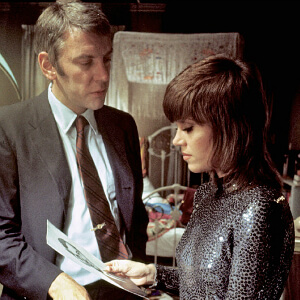
The Woman’s Film
“The rhythms of melodrama and the rhythms of character study are totally different,” Pakula said. “A melodrama has a kind of inevitable, relentless rhythm. A character study has a much more leisurely rhythm…what I wanted to do was to make [them] come together, and make them be one and the same.”
It’s a brilliant idea, and like most brilliant ideas, not original. Klute is rather a ‘70s version of Now, Voyager , with its interests in psychoanalysis, the need to feel beautiful, the need to be loved, and, naturally, the quest to transform oneself. Most of those concerns are common in “The Woman’s Film,” a genre with numerous triumphs, spanning from the ‘30s to the ‘50s. Some feminists are still derisive of this kind of filmmaking, and at the time of Klute ’s production, there was a strident consensus on the subject. Haskell was an exception, arguing in her definitive work From Reverence to Rape that many of the leads in “The Woman’s Film,” amidst others from the era, simply reflected “a deep polarity within women themselves.”*****
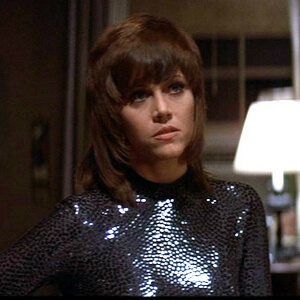
Collision of Opposites
“[Pakula] had a profound interest in and empathy for women’s emotional and psychological processes…” Fonda relays. “He had a fascination, as I do, for why people do the things they do.” This inquisitiveness wasn’t just mining for new material — though the artist is never quite free from that impulse — it was Pakula’s desire for understanding. It was a desire that made him a great collaborator. “He loved…that he and 125 of his close friends were going to show up every morning and figure out all the problems,” Celia Costa, Pakula’s location manager for eight films, said. “He was very receptive to the…ideas of the people who worked on the film.”******
Klute buzzes with everyone’s best ideas, most of which come from Pakula’s frequent collaborators. Fonda, who would star in two more films under his direction, gives a performance that’s electrifying in its spontaneity and control; as Pauline Kael observes, “she has a special kind of smartness that takes the form of speed; she’s always a little ahead of everybody.” Michael Small, composer for nine of Pakula’s films, wrote a score with “exotic percussion — African, Chinese, you name it,” and the eerie sound of a woman singing that Pakula titled “‘the siren call’ — [not] only the signature of the killer, it’s also the very seductive force that Bree is putting out.”
And then there’s the inimitable cinematography of Gordon Willis, determining “[the] film’s visual structure as a collision of opposites.”******* At one point, calling to make an appointment with a John from a telephone booth in the middle of the afternoon, Bree is in total shadow. As she hangs up the phone, church bells begin ringing in the distance, and she crosses some invisible line where the sun reaches, illuminating her. It’s among many moments — of dark and light, man and woman, sin and self-control, victim and perpetrator, power and weakness — in a film about the battle of duality.
__________________________________________
*”I loved Protestant hymns — loved singing them and loved hearing them. Today I often find myself singing those hymns when I’m fly-fishing or pulling weeds.” Jane Fonda: My Life So Far by Jane Fonda, Random House, 2005.
**”Queen of Tarts: What is one of the Quickest Ways to Get Oscar Attention? Lie Down on the Job.” Lisa Schwarzbaum, Entertainment Weekly , 2/28/1996.
*** Alan J. Pakula: His Films and His Life by Jared Brown, Back Stage Books, 2005.
**** Pakula , Brown.
***** From Reverence to Rape by Molly Haskell, New English Library, 1974.
******Both quotes in this paragraph are from Pakula , Brown.
*******“Remembering Gordon Willis, the Cinema’s Prince of Darkness” by Richard Corliss, Time.com, May 23, 2014.
- Latest Posts

Ben studied theatre at Wisconsin Lutheran College and graduated from the film program at Full Sail University in Orlando. Moving to NYC, he worked in casting for television and wrote film reviews for Relevant Magazine. For 9 years, Ben served in various roles on staff at Acacia Theatre Company in Milwaukee; currently he continues as their media contact. Soulstice Theater produced his second play, Starlings, which the Milwaukee Journal Sentinel described as "a conversation making as smart and moving a contribution to the halting dialogue between homosexuality and Christianity as I’ve seen on stage." Recently, Ben relocated to Chicago and is trying to write the second act of his life.

- A Hero Ain’t Nothin’ But a Sandwich
- What’s Up, Doc?
You may also like
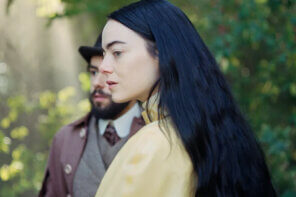
Poor Things

Oscars 2023 — Who Should Win (Part Two)

Turning Red
More stories.

Ant-Man / Bridge of Spies
Ant-Man doesn’t deserve some of its problems. A few – like “why was this made at all?” – might never be clearly resolved. That problem is wrapped firmly in the…
- The Best 1940s Cartoon Films
- The Best 1930s Comedy Movies
- The Best 1940s Dance Movies
- The Best 1940s Fantasy Films
- The Best 1940s Horror
- The Best 1940s Kids Movies
- The Best 1940s Monster Movies
- The Best 1940s Oscar Nominees
- The Best 1940s Romance Movies
- The Best 1940s Rom-Coms
- The Best 1940s Sci-Fi Flicks
- The Best 1940s Spy Movies
- The Best 1940s Thrillers
- The Best 1940s Westerns
- The Best Movies of 1940
- The Best Movies of 1941
- The Best Movies of 1942
- The Best Movies of 1944
- The Best Movies of 1945
- The Best Movies of 1946
- The Best Movies of 1948
- The Best Movies of 1947
- The Best Movies of 1949
The Best Romance Movies Of The 1940s
With this list of 1940s romance movies ranked from best to worst, you can travel back to a bygone era of cinematic romance. Modern audiences tend to lump classic films together, but '40s romantic movies vary wildly, from the madcap holiday comedy of The Philadelphia Story to the lovesick WWII drama of Casablanca . That's right, Casablanca: the film widely cited as the greatest of all time is a romance movie from the 1940s.
Naturally, it's on this list of '40s romance movies. This heartbreaking tale of star-crossed lovers starred two of the biggest movie stars of the day, Humphrey Bogart and Ingrid Bergman. This list of the best 1940s romance movies also contains such films as His Girl Friday and Meet Me in St. Louis.
Though he is best known for suspense thrillers, several of Alfred Hitchcock's best movies contain classic love stories. Notorious and Spellbound both feature great suspense as well as timeless romance.

Casablanca is undeniably one of the greatest romance films of the 1940s, capturing the essence of star-crossed love against the backdrop of wartime hardships. The enduring chemistry between Humphrey Bogart and Ingrid Bergman's characters, Rick and Ilsa, brings to life the emotional turmoil of sacrificing personal happiness for a greater cause. Their tumultuous relationship embodies the complex romantic notions of the era, with Ilsa torn between her loyalty to her husband and her passionate love affair with Rick. Furthermore, the iconic lines of dialogue throughout the film solidify Casablanca's position as an impeccable depiction of 1940s romance.
- # 60 of 262 on The 200+ Best War Movies Of All Time
- # 456 of 769 on The Most Rewatchable Movies
- # 31 of 90 on The 85+ Most Inspirational Movies Of All Time
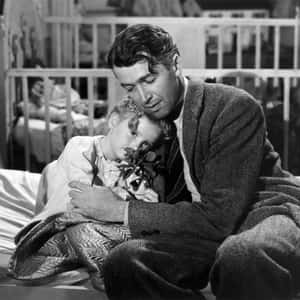
It's a Wonderful Life
It's a Wonderful Life celebrates the power of love and its ability to impact our lives in profound ways. James Stewart and Donna Reed deliver superb performances as George Bailey and Mary Hatch, whose romantic journey weaves together a tapestry of life's trials and triumphs. Set in the 1940s, the film delves into the role of love and relationships during times of uncertainty and struggle, ultimately proving that love conquers all, even when faced with insurmountable obstacles. Frank Capra's masterpiece has left an indelible mark on cinema as a prime example of the era's romantic ideals.
- Dig Deeper... It's A Wonderful Life Is Not The Heartwarming Movie You Remember
- # 277 of 769 on The Most Rewatchable Movies
- # 7 of 126 on The Best Christmas Movies Of All Time

The Ghost and Mrs. Muir
The Ghost and Mrs. Muir is a heartrending tale of love that defies the barriers of time and existence. A charming blend of romance, fantasy, and drama, the film gracefully captures the emotional bond between a lonely widow (Gene Tierney) and the ghost of a sea captain (Rex Harrison). Their unusual yet deeply touching relationship explores the themes of longing, devotion, and selflessness that were prevalent in the 40s. The beautiful cinematography and ethereal atmosphere serve to further enhance the timeless allure of this unique love story.
- # 169 of 704 on The All-Time Greatest Comedy Films
- # 72 of 91 on The 90 Best Black And White Movies
- # 213 of 251 on The 200+ Best Fantasy Movies Ever

The Shop Around the Corner
The Shop Around the Corner presents a delightfully charming and witty romance, demonstrating how love can blossom in the most unexpected of places. James Stewart and Margaret Sullavan shine as feuding co-workers who are unwittingly exchanging anonymous love letters, perfectly capturing the nuanced emotions of a blossoming romance. The film's clever exploration of the theme of hidden identities and the power of written correspondence evokes the timeless appeal of 1940s romantic ideals. With its perfect balance of humor, drama, and sentimentality, The Shop Around the Corner is a quintessential example of 40s romance.
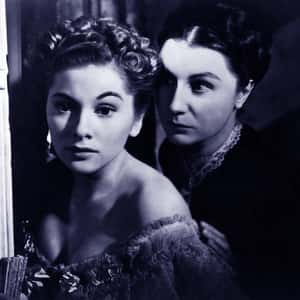
Alfred Hitchcock's classic thriller, Rebecca , masterfully intertwines romance with suspense, creating a hauntingly beautiful atmosphere. Joan Fontaine stars as the innocent and naive protagonist, trying to navigate the complexities of love and marriage in the shadow of her husband's late wife, the enigmatic Rebecca. This tale of psychological intrigue and obsession captures the tumultuous nature of relationships during the 1940s, where societal expectations and dark secrets often clashed with genuine emotion. The film's striking visual style and gripping narrative contribute to its lasting impact as a distinctive portrayal of romance in that era.
- # 129 of 252 on The 200+ Best Psychological Thrillers Of All Time
- # 49 of 96 on The Very Best Oscar-Winning Movies For Best Picture
- # 214 of 375 on The Best Movies Based On Books

Now, Voyager
Now, Voyager is an empowering and emotional journey of self-discovery and personal growth, beautifully intertwined with a tender love story. Bette Davis delivers an unforgettable performance as the repressed, pained Charlotte Vale who finds love and understanding with Paul Henreid's sensitive and compassionate Jerry Durrance. The film sensitively explores themes of mental health, societal expectations, and the transformative power of love during the 1940s. Its poignant depiction of a woman who reclaims her life and finds happiness through romance exemplifies the resilience of love during a time of adversity.
- # 262 of 675 on The Best Movies Roger Ebert Gave Four Stars
- # 245 of 473 on The 400+ Best Chick Flicks Ever
- # 15 of 75 on The 75 Best Classic Romance Movies

Laura masterfully mixes film noir elements with a passionate love story, resulting in a captivating and intriguing tale. The film's central romance revolves around a detective (Dana Andrews) who falls in love with a presumed murder victim (Gene Tierney) through her portrait, reflecting the 1940s fascination with the power of image and illusion. As the film unfolds, its mesmerizing blend of mystery, suspense, and obsession solidifies Laura's status as a unique and engrossing depiction of love during that era. The iconic cinematography and evocative score further enhance the hauntingly beautiful atmosphere, leaving an indelible mark on the classic romance genre.
- # 199 of 252 on The 200+ Best Psychological Thrillers Of All Time
- # 26 of 81 on The 75+ Best Whodunit Murder Mystery Movies
- # 202 of 228 on The 200+ Best Film Scores Of All Time
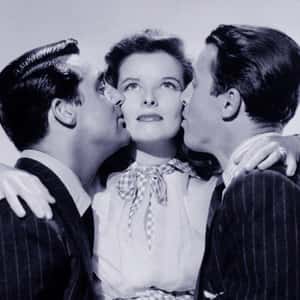
The Philadelphia Story
The Philadelphia Story is an enchanting romantic comedy that showcases the incredible chemistry between its star-studded cast – Katharine Hepburn, Cary Grant, and James Stewart. The witty banter, razor-sharp dialogue, and complex character dynamics perfectly capture the essence of 1940s high society romance. Central themes of love, heartbreak, and redemption are explored through the film's compelling narrative, in which a wealthy socialite (Hepburn) navigates the turbulent waters of her love life. This sparkling, sophisticated portrayal of romance cements The Philadelphia Story as a true classic of the 1940s.
- # 640 of 769 on The Most Rewatchable Movies
- # 179 of 704 on The All-Time Greatest Comedy Films
- # 384 of 473 on The 400+ Best Chick Flicks Ever
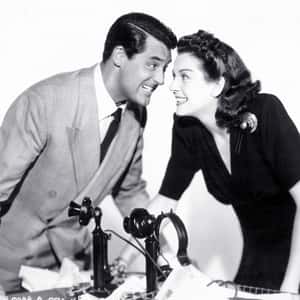
His Girl Friday
His Girl Friday is a fast-paced, clever romantic comedy that perfectly encapsulates the witty, rapid-fire dialogue and complex relationships characteristic of 1940s cinema. Cary Grant and Rosalind Russell shine as a charismatic, combative pair of ex-spouses who rekindle their romance amidst the bustling world of newspaper journalism. The film's exploration of love and ambition intertwines with themes of professional integrity and individual autonomy, reflecting the shifting societal dynamics of the era. His Girl Friday remains an enduring classic of 1940s romance, thanks to its unforgettable performances and razor-sharp humor.
- # 244 of 704 on The All-Time Greatest Comedy Films
- # 28 of 91 on The 90 Best Black And White Movies
- # 414 of 633 on The 600+ Funniest Movies Of All Time

Ball of Fire
Ball of Fire is a delightful screwball comedy that expertly blends romance and humor, resulting in a charming and engaging cinematic experience. Gary Cooper stars as a straight-laced professor who becomes enamored with a vivacious nightclub singer, played by the irresistible Barbara Stanwyck. Their unconventional relationship reflects the evolving dynamics of love during the 1940s, where opposites attract and societal norms are defied. Directed by Howard Hawks, Ball of Fire is a testament to the era's cheeky, fast-paced romantic comedies that continue to charm audiences today.
- # 5 of 60 on The Best Comedies Of The 1940s
- # 6 of 19 on The Best Gangster Movies of the 1940s
- # 14 of 71 on The 70+ Best Movies of 1941

Waterloo Bridge
Waterloo Bridge is a profoundly moving wartime romance that tugs at the heartstrings with its tale of love, loss, and sacrifice. Vivien Leigh and Robert Taylor deliver captivating performances as a ballerina and a soldier who embark on a whirlwind romance amidst the turmoil of World War II. The poignant exploration of love's endurance during times of war and separation reflects the hardships faced by many during the 1940s. The film's enduring impact can be attributed to its hauntingly beautiful cinematography and timeless narrative, solidifying its place as one of the greatest romance movies of the era.
- # 35 of 75 on The 75 Best Classic Romance Movies
- # 16 of 18 on The 18 Most Romantic Kisses in the Rain in Movie History
- # 56 of 198 on The Best Metro-Goldwyn-Mayer Movies List

Brief Encounter
David Lean's Brief Encounter is a masterful exploration of love, longing, and the power of chance encounters. The film presents the bittersweet tale of a housewife (Celia Johnson) and a doctor (Trevor Howard) who find themselves inexplicably drawn to each other, portraying the conflict between desire and duty that was prevalent in the 1940s. Their stolen moments amidst the backdrop of a bleak, post-war Britain evoke an achingly beautiful sense of passion and despair. The film's profound impact lies in its ability to evoke deep emotions through its poignant narrative and evocative soundtrack, making it an essential portrayal of romance during that time.
- # 4 of 41 on The 100+ Best Movies Streaming On The Criterion Channel
- # 44 of 48 on The Best Train Movies
- # 5 of 16 on 16 Great Movie Romances Where They Don't Get Together In The End

The Bishop's Wife
The Bishop's Wife is an enchanting and heartwarming romantic fantasy that explores the enduring power of love and faith during the holiday season. Starring Cary Grant as an angel sent to help a bishop (David Niven) and his wife (Loretta Young), the film beautifully portrays the magic of Christmas and its uncanny ability to rekindle lost connections. The tender moments shared by the characters reveal the importance of love, devotion, and selflessness within the framework of 1940s romantic ideals. The film's charming story and memorable performances have solidified The Bishop's Wife as a beloved holiday classic.
- # 64 of 126 on The Best Christmas Movies Of All Time
- # 8 of 85 on The Best Christmas Rom-Coms
- # 30 of 34 on The 30+ Best Winter Movies
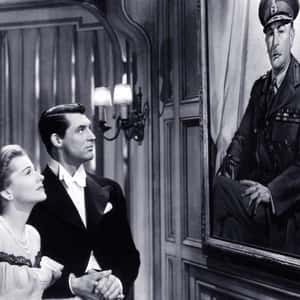
Suspicion is a thrilling romantic mystery from the master of suspense, Alfred Hitchcock. The film features Joan Fontaine as a naive young woman who falls for a charming yet mysterious playboy, played by Cary Grant, only to become increasingly suspicious of his intentions. The film's exploration of love, deception, and paranoia perfectly encapsulates the darker aspects of romance during the 1940s. Hitchcock's masterful direction, combined with captivating performances and a gripping plot, make Suspicion an essential piece of 1940s romantic cinema.
- Dig Deeper... The Best Quotes About Suspicion
- # 104 of 168 on The 160+ Scariest Psychological Thrillers
- # 18 of 33 on The Scariest Alfred Hitchcock Movies

I'll Be Seeing You
I'll Be Seeing You is a poignant and heartfelt exploration of love, vulnerability, and healing during the harsh realities of wartime life. Ginger Rogers and Joseph Cotten star as two broken souls who find solace and understanding in each other's company, forming a tender bond that transcends their troubled pasts. The film's exploration of trauma, forgiveness, and acceptance within the context of romance captures the essence of loving during a time of turmoil. Its raw emotionality and captivating performances make I'll Be Seeing You a standout example of 1940s romantic cinema.
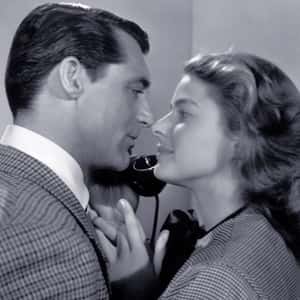
Notorious is a gripping and sophisticated romantic thriller helmed by the master of suspense, Alfred Hitchcock. Ingrid Bergman and Cary Grant sizzle onscreen as their characters navigate the treacherous world of espionage and betrayal while falling deeply in love. The film's examination of trust, loyalty, and deception within the realms of romance and politics echoes the atmosphere of uncertainty during the 1940s. Its beautifully composed shots and palpable tension make Notorious an iconic representation of love and intrigue during this significant time in history.

The Farmer's Daughter
The Farmer's Daughter is an inspiring and heartwarming romantic tale of love that blossoms between two people from vastly different worlds. Loretta Young's Oscar-winning performance as a Swedish-American farm girl who becomes romantically involved with a wealthy congressman (Joseph Cotten) is both captivating and genuine. The film's exploration of love, class, and ambition perfectly encapsulate the cultural shifts and evolving romantic ideals of the 1940s. Its charm, wit, and relatable message make The Farmer's Daughter a truly satisfying example of romance during this time period.
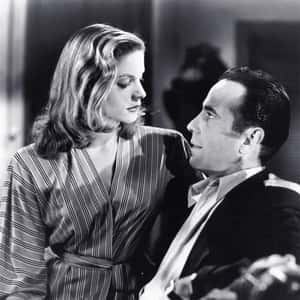
To Have and Have Not
To Have and Have Not is a captivating wartime romance that marks the first onscreen pairing of Hollywood legends Humphrey Bogart and Lauren Bacall. Their electrifying chemistry, along with the film's thrilling blend of action and intrigue, creates a mesmerizing love story set against the backdrop of World War II. The smoldering passion and underlying tension within their relationship evoke the emotional intensity of 1940s romance. Directed by Howard Hawks, To Have and Have Not remains a timeless treasure of classic film, showcasing the unbridled power of love amidst adversity.
- # 42 of 91 on The 90 Best Black And White Movies
- # 11 of 75 on The 75 Best Classic Romance Movies
- # 3 of 17 on 17 Movies That Totally Shattered Celebrity Marriages

The Clock is a tender and emotional wartime romance that portrays the fleeting nature of love in a world consumed by conflict. Judy Garland and Robert Walker deliver heartfelt performances as a young woman and a soldier who embark on a whirlwind romance during his brief leave from duty. The film's portrayal of the power of love amidst the uncertainty of war resonates deeply with the struggles faced by many during the 1940s. The Clock's beautiful cinematography and poignant narrative make it a haunting and unforgettable portrayal of love during wartime.
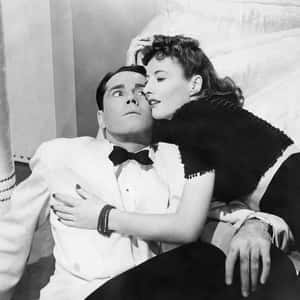
The Lady Eve
The Lady Eve is a delightful screwball comedy that expertly weaves romance, deception, and humor into a fast-paced and enchanting narrative. Barbara Stanwyck shines as a cunning con artist who finds herself falling for her unsuspecting target, played by the endearing Henry Fonda. Their captivating chemistry and sharp verbal sparring embody the wit and charm of 1940s romantic comedies. The Lady Eve's clever plot twists, engaging characters, and effortless humor solidify its status as a beloved classic of the era.
- # 229 of 473 on The 400+ Best Chick Flicks Ever
- # 587 of 633 on The 600+ Funniest Movies Of All Time
- # 29 of 75 on The 75 Best Classic Romance Movies

Meet Me in St. Louis
Meet Me in St. Louis is a vibrant and nostalgic musical that captures the enchanting spirit of romance during the turn of the century. Judy Garland shines as a young woman who falls in love with her handsome neighbor (Tom Drake) against the backdrop of the 1904 World's Fair. The film's wholesome themes of love, family, and tradition perfectly encapsulate the romantic ideals that resonated with audiences during the 1940s. With its iconic songs, vibrant Technicolor, and heartwarming story, Meet Me in St. Louis remains a beloved classic of romantic cinema.
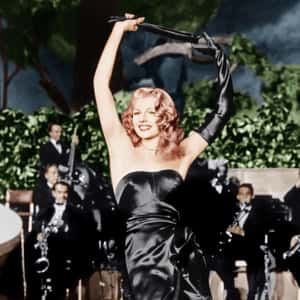
Gilda is a captivating noir romance soaked in intrigue, jealousy, and desire, set against the opulent backdrop of Buenos Aires. Rita Hayworth delivers her most iconic performance as the seductive and enigmatic Gilda, who finds herself caught in a dangerous love triangle with her husband and former lover. The film's portrayal of romantic obsession and betrayal mirrors the tumultuous emotional landscapes of 1940s relationships. Gilda's magnetic charisma and striking visuals make it an essential part of any exploration of romance from this fascinating time in history.
- # 11 of 30 on The Best Movies About Gold Diggers
- # 22 of 92 on The 90+ Best Film Noirs Of All Time
- # 23 of 419 on The 400+ Best Movies Produced By Columbia Pictures

Adam's Rib is a witty and thought-provoking romantic comedy that explores the intricacies of married life with humor and insight. Starring Katharine Hepburn and Spencer Tracy as a husband-and-wife attorney team who find themselves on opposing sides of a high-profile case, the film delves into the complexities of love, gender roles, and professional rivalry. The sharp, engaging dialogue and undeniable chemistry between the leads perfectly capture the evolving romantic attitudes of the 1940s. This charming and entertaining portrayal of matrimony remains an essential example of the era's romantic cinema.
- # 326 of 704 on The All-Time Greatest Comedy Films
- # 26 of 65 on The Funniest Movies About Marriage
- # 6 of 33 on The Best Romantic Comedies of the 1940s

The More the Merrier
The More the Merrier is a charming and effervescent romantic comedy set against the backdrop of wartime housing shortages in Washington D.C. Jean Arthur and Joel McCrea play two mismatched roommates who find themselves unexpectedly drawn to each other despite their differences. The movie explores themes of love, friendship, and the importance of human connection in a time of global strife. With its witty humor, endearing characters, and authentic depiction of 1940s life, The More the Merrier remains a beloved classic in the realm of romantic cinema.

Woman of the Year
Woman of the Year is a charming and thoughtful romantic comedy that marks the beginning of one of Hollywood's most iconic onscreen partnerships – Katharine Hepburn and Spencer Tracy. Their magnetic chemistry is palpable as their characters navigate the complexities of love, career, and societal expectations that defined the era. Hepburn's portrayal of a confident, independent woman challenged traditional gender roles while showcasing the intricate dance between ambition and romance during the 1940s. The film's wit, charm, and enduring appeal make Woman of the Year a significant touchstone in the evolution of romantic cinema.
- # 301 of 704 on The All-Time Greatest Comedy Films
- # 463 of 633 on The 600+ Funniest Movies Of All Time
- # 31 of 59 on The 50+ Best Sports Romance Movies
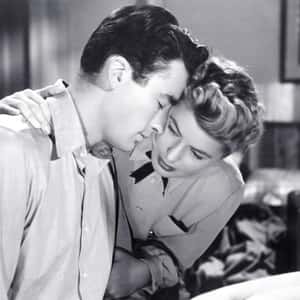
Spellbound is a suspenseful and intoxicating romantic thriller directed by the master of suspense, Alfred Hitchcock. Ingrid Bergman and Gregory Peck star as a psychiatrist and an amnesiac patient who fall in love while unraveling a dark and mysterious past. The film's exploration of love, psychology, and the subconscious perfectly encapsulates the evolving romantic ideals of the 1940s. With its haunting visuals and memorable score by Miklós Rózsa, Spellbound remains an enthralling cinematic experience that showcases the power of love amidst uncertainty and danger.
- # 213 of 252 on The 200+ Best Psychological Thrillers Of All Time
- # 56 of 81 on The 75+ Best Whodunit Murder Mystery Movies
- # 118 of 168 on The 160+ Scariest Psychological Thrillers
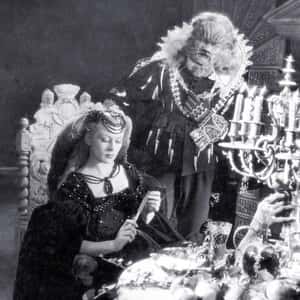
Beauty and the Beast
Beauty and the Beast is a visually stunning and enchanting adaptation of the classic French fairy tale that explores the transformative power of love. Jean Marais and Josette Day star as the cursed Beast and the beautiful, compassionate Belle, whose love ultimately breaks the spell that imprisons him. The film highlights the themes of love's ability to transcend appearances and flaws, reflecting the Romantic ideals prevalent in the 1940s. Jean Cocteau's exquisite direction and captivating use of visual effects make Beauty and the Beast a timeless masterpiece of romantic cinema.

The Razor's Edge
The Razor's Edge is a soul-searching and introspective romantic drama that delves into the complexities of love, self-discovery, and the search for meaning in life. Based on W. Somerset Maugham's novel, the film stars Tyrone Power as a disillusioned World War I veteran who embarks on a spiritual journey that takes him from high society to the Far East. As he navigates the complicated terrain of love, loss, and redemption, the film explores the evolving nature of romance during the 1940s. The Razor's Edge remains a thought-provoking and poignant examination of the human capacity for love and transformation.

That Hamilton Woman
That Hamilton Woman is a mesmerizing historical romance that portrays the tumultuous love affair between British naval hero Admiral Lord Nelson (Laurence Olivier) and his mistress Emma Hamilton (Vivien Leigh). The film's sumptuous costumes, lavish sets, and passionate performances transport viewers back in time, immersing them in a world of high society glamour and forbidden romance. Its exploration of love, power, and reputations amidst political intrigue and warfare reflects the complexities of relationships during the 1940s. That Hamilton Woman remains an enduring classic, thanks to its enthralling narrative and unforgettable performances.
- # 48 of 80 on The Best Period Romance Movies
- # 41 of 75 on The 75 Best Classic Romance Movies
- # 27 of 71 on The 70+ Best Movies of 1941

Letter from an Unknown Woman
Letter from an Unknown Woman is a haunting and emotionally charged romance that tells the poignant story of unrequited love and longing. Joan Fontaine delivers a powerful performance as a woman who writes a heartrending letter to her former lover (Louis Jourdan), recounting their brief encounters over the years. The film delves into themes of love, loss, and memory, evoking the intense and passionate emotions that typified 1940s romance. With its evocative cinematography and compelling narrative, Letter from an Unknown Woman has become an enduring classic of romantic cinema.
- Entertainment
- Classic Movies
- Romantic Movies
- Watchworthy
Lists that rank the top movies to grace the silver screen between 1940 and 1949.

Now, Voyager (1942)
Full cast & crew.

Directed by
Writing credits , cast (in credits order) verified as complete , produced by , music by , cinematography by , editing by , art direction by , set decoration by , costume design by , makeup department , production management , second unit director or assistant director , art department , sound department , special effects by , stunts , camera and electrical department , costume and wardrobe department , editorial department , music department , script and continuity department , additional crew .
Release Dates | Official Sites | Company Credits | Filming & Production | Technical Specs
Contribute to This Page
- Full Cast and Crew
- Release Dates
- Official Sites
- Company Credits
- Filming & Production
- Technical Specs
- Plot Summary
- Plot Keywords
- Parents Guide
Did You Know?
- Crazy Credits
- Alternate Versions
- Connections
- Soundtracks
Photo & Video
- Photo Gallery
- Trailers and Videos
- User Reviews
- User Ratings
- External Reviews
- Metacritic Reviews
Related Items
- External Sites
Related lists from IMDb users

Recently Viewed

COMMENTS
Led by Kathryn Janeway (Obie-Award-winner Kate Mulgrew ), the first female Trek captain to carry a series, Voyager brought us some of the most convulsively inventive humanist science fiction this side of early Stephen Moffat-era Doctor Who . Set in the 2370s, Voyager episodes ping-ponged wonderfully between genres and modes.
Boston spinster Charlotte has had her life controlled entirely by her wealthy mother, Mrs. Henry Vale. Feeling despondent, she's convinced to spend time in a sanitarium. Soon she is transformed into a sophisticated, confident woman. On a cruise to South America, Charlotte meets and begins an affair with Jerry Durrance, a married architect.
Irving Rapper was a vocal coach, dialogue director, and assistant director in the 1930s who, prior to "Now, Voyager," had directed only three features, including "One Foot in Heaven" (1941) starring Fredric March and Martha Scott, and "The Gay Sisters" (1942) with Barbara Stanwyck. In the end, just like Bette Davis, he was not the ...
Vox Media. Nov. 7, 2017. 75 Years Later, Now, Voyager Remains a Poignant Depiction of Mental Illness. ByAngelica Jade Bastién, a New York and Vulture critic covering film and pop culture. Bette ...
Now, Voyager: Directed by Irving Rapper. With Bette Davis, Paul Henreid, Claude Rains, Gladys Cooper. A frumpy spinster blossoms under therapy and becomes an elegant, independent woman.
Travel - broadening the mind, personal horizons and a lonely woman's perceptions of self - is one of many tonics taken by an irrepressible Bette Davis as the traumatised Charlotte Vale in Now, Voyager.Irving Rapper's 1942 film, shining in crisp, crystalline monochrome, after a 2K digital restoration by Warner Brothers, returns to UK screens this month thanks to the BFI.
Picture 8/10. The Criterion Collection presents Irving Rapper's Now, Voyager on Blu-ray in its original aspect ratio of 1.37:1 on this dual-layer disc. The film receives a 1080p/24hz high-definition encode sourced from an all-new 4K restoration, which was scanned primarily from the 35mm nitrate negative. A 35mm nitrate fine-grain was used to ...
June 21, 2005. Irving Rapper's Now, Voyager remains a highly narcotic, swoon-inducing romance in the Bette Davis canon. It's an unabashed soap opera about how true love gets hindered by social conventions, and manages to squeeze in a moralistic tale of female self-empowerment to boot. Toss in a third-act bit of passive-aggressive wish ...
Boston heiress Charlotte Vale (Bette Davis) is a neurotic mess, largely because of her domineering mother (Gladys Cooper). But after a stint in a sanatorium where she receives the attention of Dr ...
Now, Voyager follows the affluent Charlotte Vale (Bette Davis), stunted after having grown up under the heel of her puritanical and controlling mother (Gladys Cooper), and who remains convinced of her own unworthiness until a kindly psychiatrist, Dr. Jaquith (Claude Rains), gives her the confidence to set out on a restorative South American cruise. ...
Now, Voyager is a 1942 American drama film starring Bette Davis, Paul Henreid, and Claude Rains, and directed by Irving Rapper.The screenplay by Casey Robinson is based on the 1941 novel of the same name by Olive Higgins Prouty.. Prouty borrowed her title from the Walt Whitman poem "The Untold Want," which reads in its entirety, . The untold want by life and land ne'er granted,
Now filmmaker Steve James has produced a documentary about his life and death, called Life Itself. In 2002, Ebert was diagnosed with cancer. Four years later, he had surgery to remove part of his ...
He's corny. He's melodramatic. And he has a sizable ego. But he's really not a bad actor. We forget that before "Star Trek," Shatner seemed destined to become a fine stage actor. He first made the trip to Broadway from his native Canada in 1956 with a small part in "Tamburlaine the Great" in 1956. The production had two Tony nominations.
A tender love story, a taut psychological drama, an inspiring tale of physical and spiritual transformation. Now, Voyager is all three, as well as a Bette Davis career milestone, resulting in her sixth Best Actress Oscar nomination. She magically plays Charlotte Vale, a spinster who defies her domineering mother (fellow Oscar nominee Gladys Cooper) to discover love, heartbreak and eventual ...
Klute is rather a '70s version of Now, Voyager, with its interests in psychoanalysis, the need to feel beautiful, the need to be loved, and, naturally, the quest to transform oneself. Most of those concerns are common in "The Woman's Film," a genre with numerous triumphs, spanning from the '30s to the '50s.
More Now, Voyager #262 of 675 on The Best Movies Roger Ebert Gave Four Stars #245 of 473 on The 400+ Best Chick Flicks Ever #15 of 75 on The 75 Best Classic Romance Movies; 7. Laura. Gene Tierney, Dana Andrews, Clifton Webb. 66 votes. Laura masterfully mixes film noir elements with a passionate love story, resulting in a captivating and ...
Now, Voyager (1942) cast and crew credits, including actors, actresses, directors, writers and more. Menu. Movies. Release Calendar Top 250 Movies Most Popular Movies Browse Movies by Genre Top Box Office Showtimes & Tickets Movie News India Movie Spotlight. TV Shows.
Music by. Leonard Rosenman. When they finished writing the script for "Star Trek IV," they must have had a lot of silly grins on their faces. This is easily the most absurd of the "Star Trek" stories - and yet, oddly enough, it is also the best, the funniest and the most enjoyable in simple human terms. I'm relieved that nothing like restraint ...
Leterrier's new film, "Now You See Me," is in some ways a return to his roots. Like his two "Transporter" movies, it's light on seriousness and heavy on style — a razzle-dazzle fantasy about a team of bank-robbing illusionists. It's slick, deliberately silly, and sprinkled with visual confetti — Steadicam spins, lens flares, CGI trick ...
Now comes "The Last Voyage of the Demeter," a feature-length expansion of those 16 pages that fully examines the strange occurrences aboard one of the most doomed sea journeys in literary history. Upon hearing this movie's premise for the first time, I wasn't entirely convinced it could work. This would be a film where practically every ...